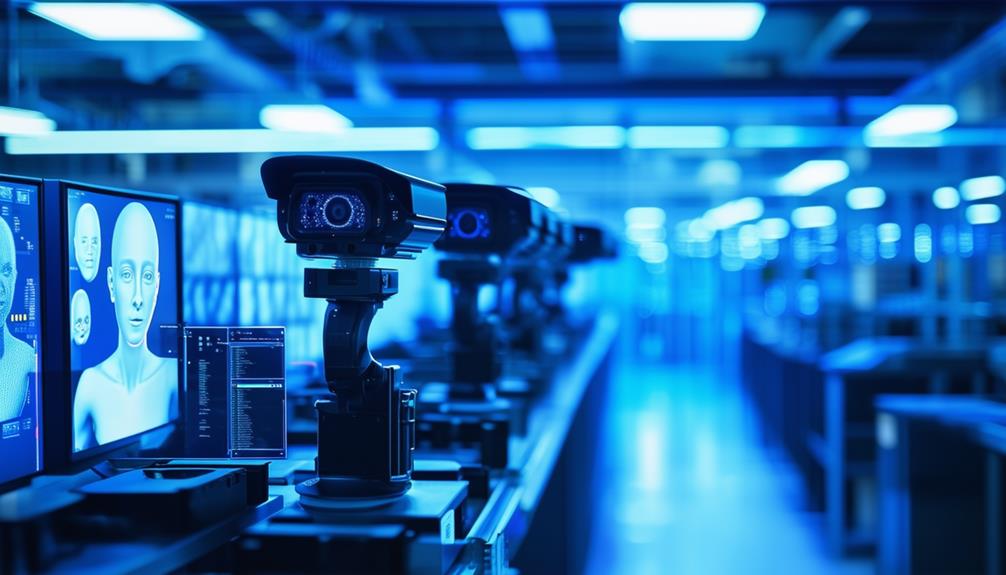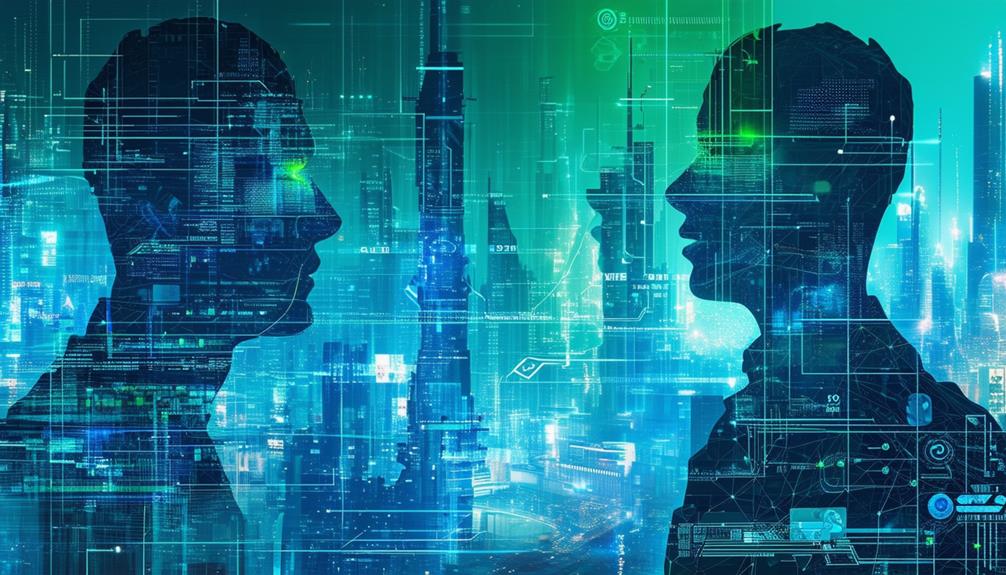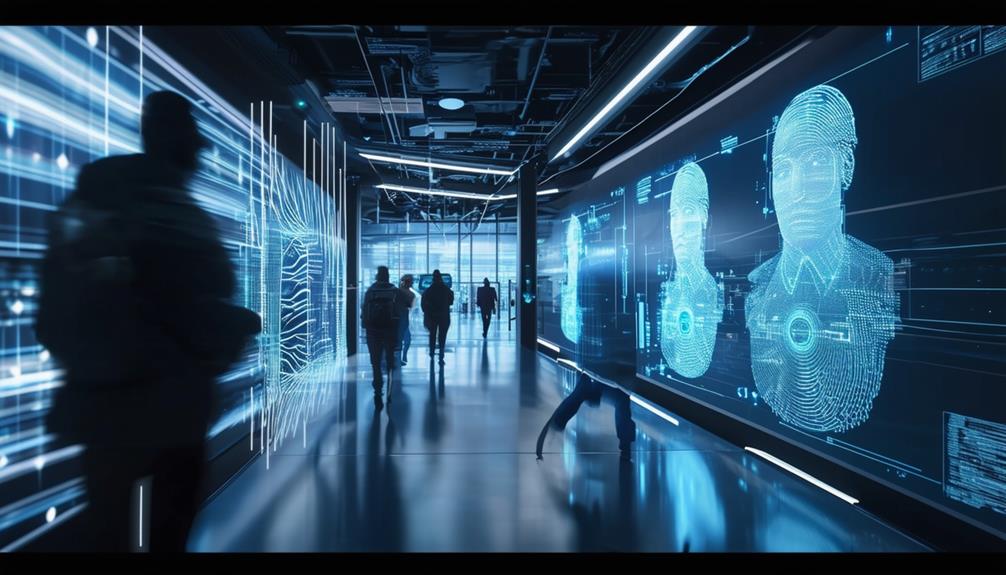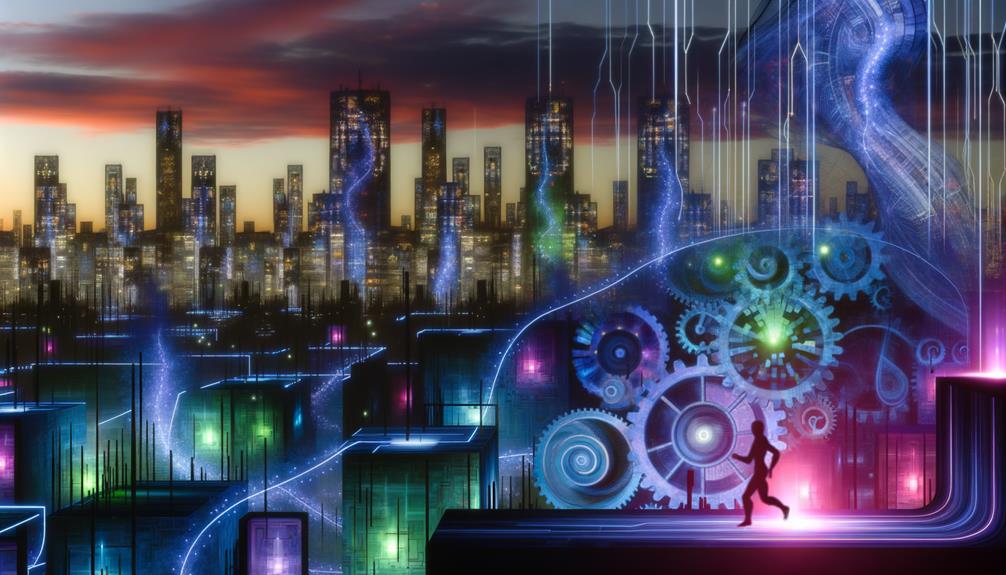Facial recognition technology has taken a significant leap forward with the incorporation of deep learning algorithms. Google's FaceNet, for instance, boasts an impressive 99.63% accuracy rate. India's Automated Facial Recognition System (AFRS), designed for criminal identification, is another milestone. Innovative applications include lie detection and age verification, enhancing security measures and access control. Interested in more detailed applications and automations?
Key Takeaways
- Facial recognition technology integrates deep learning algorithms like DeepFace and FaceNet for high accuracy and efficient tracking.
- AI-based recognition boosts multifactor authentication for secure identity verification and access control.
- Behavioral biometrics and voice recognition enhance security protocols by integrating with facial recognition.
- Real-time facial detection optimizes public event security and law enforcement operations.
- Precise tracking applications combine facial features with AI-driven processing for efficient real-time identity verification.
New Face Recognition Capabilities
The capabilities of facial recognition technology have advanced dramatically, boasting record-breaking accuracy rates and innovative applications that are transforming multiple industries. Facial recognition systems now leverage deep learning algorithms to map facial features with unprecedented precision. This has led to a significant jump in recognition accuracy. For instance, Google's FaceNet has achieved an astonishing 99.63% accuracy rate, demonstrating the technology's remarkable potential.
In India, the government has implemented the Automated Facial Recognition System (AFRS), specifically designed to identify and track criminals. This is an example of how facial recognition technology is being adopted for critical security purposes. Such systems have also improved access control features, integrating advanced video authorization and multi-factor authentication mechanisms.
Advancements in artificial intelligence have brought new possibilities to the forefront. Facial recognition now extends to innovative applications such as lie detection and age verification for online platforms. This technology is also becoming more ubiquitous, being integrated into personal devices like smartphones and virtual assistants, revolutionizing personalized interactions and user experiences.
Enhanced Personalized Assistance
As personal devices and virtual helpers increasingly incorporate facial recognition, I anticipate that my interactions with them will become even more customized to fit my individual preferences and expressive cues. The merging of facial recognition technology with personalized support is set to transform how I communicate with these systems.
By identifying emotions and social cues, these helpers can adjust their responses to better match my needs and preferences, creating a more dynamic and efficient interaction. This enhanced capability will enhance user experiences by enabling helpers to visually comprehend my behavior and respond accordingly.
For example, if I display visible distress, my helper might proactively offer soothing suggestions or relevant resources. The technology's capacity to monitor and analyze facial expressions guarantees that it can better grasp the subtleties of human communication, leading to more compassionate and organized assistance.
Ultimately, the combination of facial recognition and personalized support is positioned to redefine the boundaries of instinctive interaction, aligning technology with the nuances of human expression and nurturing deeper connections between users and their personal aides.
AI Boosts Facial Recognition

By integrating artificial intelligence into facial recognition technology, I've seen a notable leap in accuracy and efficiency, as algorithms like GaussianFace, FaceNet, and DeepFace continue to raise the bar for biometric identification. These advancements are essential for various applications, including security, healthcare, and retail. Facial recognition systems leveraging AI now excel in image processing and analysis, reducing errors and increasing the effectiveness of security systems. Additionally, AI-enhanced algorithms have improved the detection accuracy by more than 27%, largely due to their ability to handle large datasets efficiently.
| System | Accuracy | Description |
|---|---|---|
| DeepFace | 97.35% | Uses a nine-layer deep neural network, reporting a notable reduction in error rate compared to the state of the art. |
| GaussianFace | N/A | Employing Gaussian distributions for face representations, this method contributes to the robustness of facial recognition. |
| FaceNet | 99% | Utilizes image embeddings to measure the similarity between facial images, achieving high accuracy in face verification. |
This harmony of AI and facial recognition has also driven the market to substantial growth, with the global facial recognition technology market projected to exceed USD 19.3 billion by 2032.
Biometric Authentication Advancements
As facial recognition technology evolves, I explore the advancements in biometric authentication, where AI algorithms accurately identify individuals based on facial features like ethnicity, gender, and age.
This enhancement enables secure identity verification and boosts security features such as video authorization and multi-factor authentication.
Let's examine how facial recognition progress operates in devices such as smartphones and drones for applications including employee attendance monitoring and crime prevention.
Face Authentication Efforts
Facial identification technology has swiftly advanced, with various algorithms and systems achieving exceptionally high accuracy levels, as exemplified by the GaussianFace algorithm's score of 98.52% and Google's FaceNet setting a record at 99.63%. These remarkable achievements underscore the significant strides made in recognition and tracking technology.
Notable programs like Facebook's DeepFace have also pushed the boundaries of facial identification, achieving an accuracy rate of 97.25%. Thales' facial recognition software (LFIS) demonstrated a remarkable face acquisition rate of 99.44% in less than 5 seconds.
Facial identification systems have become increasingly reliable and efficient, leveraging image recognition to perform facial authentication with impressive precision. These advancements in recognition technologies have numerous applications, from ensuring security to enhancing user experiences. The critical aspect of facial identification lies in its ability to verify identities accurately and swiftly, making it an invaluable tool across various industries.
Secure Identity Verification
Advancements in facial recognition technology have expanded biometric authentication options for secure identity verification. Facial recognition systems have experienced significant accuracy improvements, achieving identification scores of over 98%, guaranteeing a secure method of verifying identities.
This cutting-edge technology leverages unique facial characteristics to create digital templates, allowing for quick comparisons with stored data. With the ability to analyze facial features at high speed, image processing efficiency has substantially enhanced the security measures in public spaces and access control scenarios.
Integration of facial recognition is now seen across various sectors, including healthcare for patient identification and law enforcement for criminal identification, reflecting its versatility and effectiveness. As the global market for facial recognition technology is projected to exceed USD 19.3 billion by 2032, advancements are anticipated to continue, addressing individual preferences for enhanced security and efficiency.
The integration of these systems promises to revolutionize the way we guarantee secure identity verification. By adopting facial recognition technology, our personal and digital spaces can become safer, making our lives and transactions more secure.
AI Enhanced Security
The integration of artificial intelligence with biometric technology has greatly strengthened security measures by providing unique and accurate user identification, effectively bolstering access controls through enhanced facial recognition and behavioral biometric analysis. The efficacy of AI-enhanced security systems is deeply rooted in their ability to verify identities quickly and precisely, making them essential components in securing sensitive information and restricted areas.
Key features of these advanced systems include:
- Facial Recognition Systems: AI-powered facial recognition algorithms can accurately identify individuals even under challenging conditions like variable lighting or angles, ensuring swift and reliable authentication.
- Voice Recognition: AI-driven voice recognition technology analyzes distinctive voice patterns, allowing for seamless verification in telephone-based systems or personal devices.
- Fingerprint Recognition: Enhanced fingerprint matching algorithms enabled by AI guarantee prompt and accurate identification, making them ideal for access control and financial transactions.
These technologies, when combined with robust multifactor authentication strategies, create a formidable defense against unauthorized access and fraudulent activities, setting new standards in security protocols for various industries.
Moroscopic Technology Applications

In the field of moroscopic technology, facial recognition plays a significant role in multiple applications.
From efficiently tracking employee attendance to matching faces to identify criminals, AI algorithms continue to enhance facial recognition speed and accuracy.
These advancements have significant implications for surveillance, security, and the reinvention of identity verification methods.
Moroscopic Surveillance
When law enforcement agencies need to track an individual in crowded areas, moroscopic surveillance leveraging facial recognition technology steps in to facilitate real-time identification and tracking. Facial recognition systems are integrated into surveillance cameras and access control systems, enabling the accurate detection of individuals in public spaces, airports, and border control. This technology guarantees heightened security measures by aiding in the identification and tracking of individuals.
- Real-time tracking at public events
- Enhanced security at airports and border control
- Efficient tracking for law enforcement
Face Matching Accuracy
Moroscopic technology applies to advanced facial recognition systems by enhancing face matching accuracy through detailed features such as eye distance and nose shape, thereby reducing false matches and improving identification precision. This approach greatly boosts the performance of facial recognition systems, ensuring they remain reliable and efficient.
By focusing on individual facial traits, moroscopic technology emphasizes unique characteristics that define each person, minimizing errors and misidentification.
In facial recognition systems, face analysis is critical for achieving high accuracy rates. Moroscopic applications excel in this regard, leveraging algorithms that meticulously evaluate facial features like the distance between the eyes, nose shape, and skin texture. The precision of these systems is remarkable, with many achieving accuracy rates exceeding 99%.
The impact on security measures can't be overstated, as enhanced face matching accuracy translates into improved identification and reduced risk.
Enhancing face analysis through moroscopic technology not only increases the precision of facial recognition systems but also contributes to the development of more reliable surveillance methods. This precision is particularly critical in sensitive applications, such as law enforcement and national security, where the accuracy of identification is paramount.
Reinventing Identity Verification
Reinventing Identity Verification
As advancements in facial recognition technology grow significantly, it highlights the importance of advanced facial recognition systems that deploy moroscopic technology. This technology leverages facial features for identity verification, analyzing facial characteristics like the shape of the eyes and nose. Unlike traditional methods, moroscopic identification is based on visual inspection rather than measurements. This approach enhances security measures by accurately preventing identity fraud.
To better comprehend the potential of moroscopic technology, consider the following scenarios:
- Enhanced Access Control: Moroscopic facial recognition systems can securely verify identities, ensuring that only authorized individuals gain access to sensitive areas.
- Streamlined Authentication: Integration of moroscopic technology simplifies verification processes, eliminating the need for lengthy documentation or additional authentication steps.
- Effective Surveillance: Advanced facial recognition capabilities facilitate real-time detection and tracking of individuals, bolstering security and public safety.
Facial Detection for Security
Facial detection technology has become an essential component in modern security systems, able to accurately identify individuals based on facial features such as ethnicity, gender, and age. This advanced technology is integrated into various security applications, including access control, surveillance, and law enforcement for criminal identification.
I'm particularly intrigued by the high accuracy rates of facial recognition systems, with some algorithms reaching up to 99.63% precision. This level of precision enables effective facial detection and tracking in real-time, facilitating enhanced security measures in both public spaces and private facilities.
Facial expressions are another key aspect considered by recognition software to identify individuals. Not only do these systems enhance security, but they also have a significant impact on business operations. By streamlining identification processes, companies can improve efficiency and reduce potential security risks.
Additionally, facial detection technology has been successfully implemented in systems like India's Automated Facial Recognition System (AFRS), which has improved the speed and accuracy of criminal identification and tracking. As this technology continues to evolve, it will be fascinating to see how its applications expand and improve overall security and efficiency in various industries.
Real-Time Identity Verification

Switching to real-time identity verification, I implement facial recognition to instantly authenticate individuals via secure access control leveraging facial features. This technology revolutionizes cybersecurity by decreasing the risk of identity fraud.
Real-time identity verification makes it possible to process verifications in mere seconds, providing smooth user experiences and stringent security measures.
Here are three key aspects of this technology:
- Neural Network Accuracy: Advanced neural networks in facial recognition systems guarantee precise matches, reducing false positives and enhancing the overall security framework.
- Lightning-Fast Processing Speed: Real-time identity verification can process and confirm identities in seconds, eliminating lengthy wait times and enabling swift access to secure systems.
- Convenience and Efficiency: With real-time identity verification, users need only present their face to a camera, streamlining the verification process, reducing the need for physical tokens or passwords, and enhancing overall convenience.
Frequently Asked Questions
What Is the Future of Facial Recognition Technology?
The future of facial recognition technology, which embodies advancements in speed and accuracy while facing ethical concerns and privacy implications, holds significant societal impact and promises increased security in various sectors.
What Technology Is Used for Facial Recognition?
Here are some of the key technologies used for facial recognition: "Given the advancements in AI, I use facial recognition algorithms built on deep learning models and image processing techniques for biometric authentication. These systems suit my needs for reliable identification."
What Is the Technology Behind Face Id?
As an enthusiast of biometric authentication, I rely on Face ID's advanced facial recognition algorithm, powered by machine learning, to secure my device with unparalleled precision and convenience, ensuring freedom from cumbersome passwords.
How Is Facial Recognition Used in Law Enforcement?
As a law enforcement officer, I utilise facial recognition technology to surveil suspects, yet I acknowledge the privacy concerns and accuracy issues that may stem from biases. Public opinion varies, but its role in enhancing public safety is undeniable.








